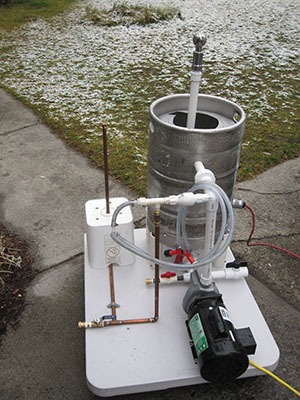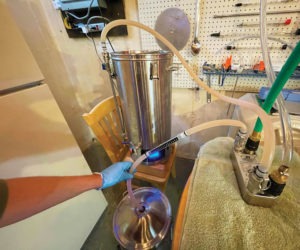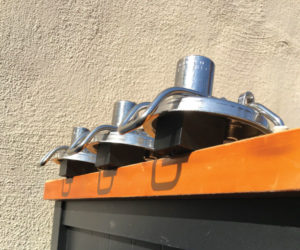Build a Keg Washer

My pump kept going into thermal shutdown (I like my PBW hot) and then started leaking oil. It was time to up my cleaning game.
The system I designed accomplishes rinsing, cleaning, and re-rinsing of kegs with minimal changing of hoses. When the cleaning and rinsing cycles are finished, the kegs are ready to be broken down and sanitized.
To achieve this the system uses a re-purposed keg as the cleaning solution vessel (CSV). It is outfitted with a drain in the bottom (I used a stainless steel bar sink drain from the hardware store for a weldless solution), an electric element to keep the solution hot, and a temperature probe for the element’s controller. The heating element shouldn’t be left out of this project as effective CIP cleaning (in a reasonable amount of time) requires a hot cleaning solution. The top of the keg is cut to support the handles of a corny keg, with notches for clearance of the port cleaning hoses.
The pump I used is an AMT 429B-98. This is a 3⁄4 horsepower pump with a stainless head. Its seals are chemical resistant and it is rated for fluids up to 200 °F (93 °C). These pumps are usually cost-prohibitive for homebrewers, but I found a new one on eBay for under $200. You don’t have to buy this exact pump to build a great CIP system, but I would recommend something with at least 1⁄2 HP and the above-mentioned properties for safe, effective cleaning.
Cleaning solution is pumped from the CSV and up through a stainless spray ball that sits inside the inverted corny keg. The solution drains out of the keg and back into the cleaning solution vessel. There is a 1⁄2 in. (13 mm) port on the 90° elbow above the pump that allows the cleaner to flow through a check valve and into the two hoses that connect to the liquid and gas ports of the corny keg.
When washing is complete, the port cleaning hoses stay connected to the ports. The corny keg is removed from atop the cleaning vessel and placed on the rinsing wand. The rinsing wand (a vertical copper pipe drilled with a series of 1⁄8-inch/3-mm holes) and its plumbing are all made of potable water rated components (CPVC and copper). When the rinse water valve is opened, cold tap water flows to the rinsing wand and through a tee and a check valve to the port cleaning hoses. The check valve on the cleaning side prevents rinse water from entering the cleaning loop, just as the check valve on the rinse side prevents cleaning solution from entering the rinse apparatus. Once the keg has been sufficiently rinsed, it is ready to be broken down and sanitized.
To put the unit into storage I disconnect power from the pump and heating element and open the dump valve (see photo). When the cleaning solution has emptied I close the dump valve and then hook a fresh tap water hose to the feed side of the pump and close the valve below the vessel. This forces the rinse water up through the pump and the spray ball. It’s handy to have a spare corny keg sitting on the unit for this so you don’t get soaked! Finally, I re-open the dump valve and open the valve directly below the CSV and give it a good hand rinsing.
Since your pump may vary from mine, the materials list is approximate. Pick out the fittings that suit your needs to accomplish the same functions as my machine.
This is an advanced project that should only be attempted by those familiar with plumbing and wiring. If any parts of this project are assembled improperly you risk failure of key components, injury, electrocution, and making a gigantic mess.
BUILD YOUR OWN CIP SYSTEM
Materials:
* A base for the project, preferably with wheels. I used a plastic table top screwed to a plastic furniture dolly.
* 10 ft. (3 m) length of 1 in. (26 mm) schedule 40 PVC pipe (or appropriate diameter for your chosen pump)
* PVC cement
* (2) 1 in. (26 mm) PVC valves (I like to use a “socket” style valve for easy disassembly)
* Stainless bar sink drain kit and reducers to attach the 1.5-in (38-mm) drain pipe to 1 in. (26 mm) PVC.
* 1 in. (26 mm) schedule 40 PVC cross
* 2 garden hose adapters
* 1 in. (26 mm) PVC elbows (quantity and types depend on your final design)
* 1 in. (26 mm) PVC elbow with 1⁄2 in. (13 mm) FPT port
* 1 in. (26 mm) PVC socket union fitting
* Brewer’s Hardware Rotating CIP Spray Ball (1 in./26 mm)
* PVC spring check valve for cleaning look
* Lead-free brass check valve for rinsing loop
* 1⁄2 in. (13 mm) CPVC tee for rinsing loop
* 1⁄4 in. (6.4 mm) barb tee for port cleaning hoses
* 8 ft. (2.4 m) clear 1⁄4 in. (6.4 mm) PVC beer line for port cleaning hoses
* Gas in and beer out fittings for corny kegs
* 6 ft. (1.8 m) of 1⁄2 in. (13 mm) copper pipe
* All of the needed copper tees and elbows for your rinsing setup
* 1⁄2 in. (13 mm) copper cap
* Lead-free solder
* Water-soluble flux
* Teflon tape
* Pump rated for high temperature chemical handling, I used a 3⁄4 HP with 1 in. (26 mm) inlet and outlet and a maximum 75 psi working pressure
* A switchbox for the pump and heating element
* Weldless temperature probe
* 2500W, 240V heating element (I run it on 120V, so it only consumes 625W of power) with stainless nut
* Heavy gauge wiring for the pump and element (at least 12 AWG)
* GFCI plug for the switch box
* 2 in. (53 mm) PVC Pipe to make supports for cleaning solution vessel
Tools Required:
* Electric drill
* Step-drill bit with max step at least 13⁄8 in. (35 mm)
* Jigsaw with high-quality metal-cutting blades
* Chopsaw for cutting PVC (not necessary, but it provides nice square cuts)
* Copper tubing cutter
* Soldering torch
* Pipe wire brushes
* Pipe wrenches
* Level
* Framing square
* Gloves
* Safety glasses
* Ear Protection



